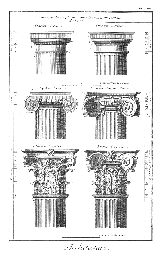Architectural and Horticultural Department.
At Objets d'Art we are fascinated by the influence of architectural style and have an ever changing eclectic inventory of useful architectural ornament. Amongst our stock you will usually find plaques, roundels, obelisks, urns, corbels, curtain poles, architrave corner blocks, stencils, Roman capitals, wood and resin applique, decorative antiques and reproduction objets.
The origins of classical architecture and their movements through Antiquity, Renaissance, Mannerist, Baroque, Neoclassical, and Georgian periods.
An architectural ‘order’ is one of the ancient styles of building design in the Classical tradition, distinguished by their proportions and their characteristic profiles and details, but most quickly recognizable by the type of column and capital employed. Each style also has its proper entablature, consisting of architrave, frieze and cornice. From the sixteenth century onwards, theorists recognized five orders.
Ranged in the engraving (see illustration), from the stockiest and most primitive to the richest and most slender, they are: Tuscan (Roman) and Doric (Greek and Roman, illustrated here in its Roman version); Ionic (Greek version) and Ionic (Roman version); Corinthian (Greek and Roman) and composite (Roman). The ancient and original orders of architecture are no more than three, the Doric, Ionic and Corinthian, which were invented by the Greeks. To these the Romans added two, the Tuscan, which they made plainer than the Doric, and the Composite, which was more ornamental, if not more beautiful, than the Corinthian. The first three orders alone, however, show invention and particular character, and essentially differ from each other; the two others have nothing but that which is borrowed, and differing only accidentally. The Tuscan is the Doric in its earliest state, and the Composite is the Corinthian, enriched with the Ionic.

Our range of horticultural items consists of smaller gifts and items with a gardening theme suitable for interior decoration,conservatories and outdoors in the garden which can be dispatched immediately and larger objects like carved stone items, armillary spheres and sundials, chimney pots and terracotta plant pots, reconstituted stone garden ornaments,statues, parasols and garden tools which are best collected or can be dispatched by special delivery if required.
Many regard the revival of the Greco-
Gothic-
Whatever style of architectural ornament you enjoy, I think we can safely predict
that the above styles will still be considered tasteful and humane when the bland
box-
One ideal of interior design is to bring the internal decor into harmony with the
style, character and proportion of the building structure itself. Thus internal ornament
(e.g. cornices, door cases, dado rails, skirtings, fire-